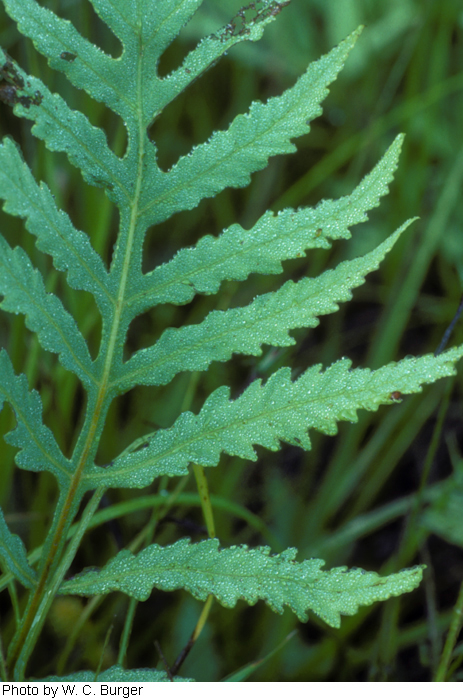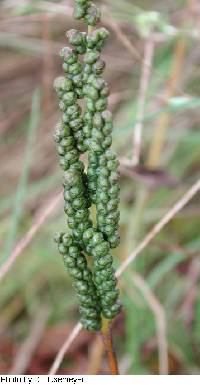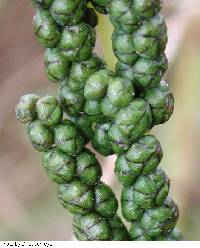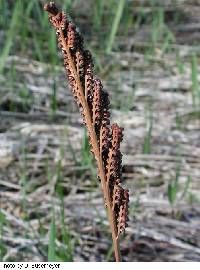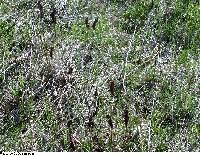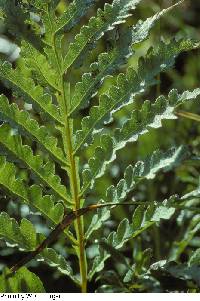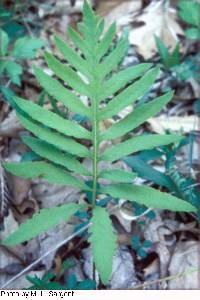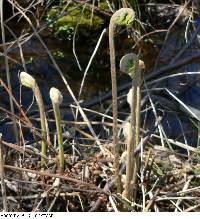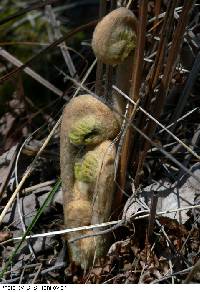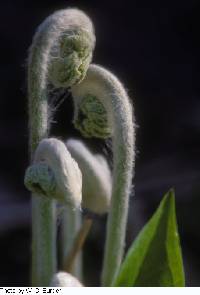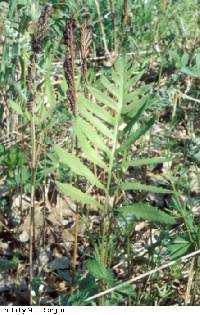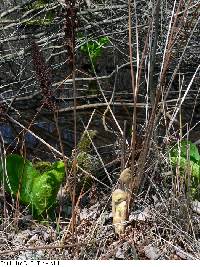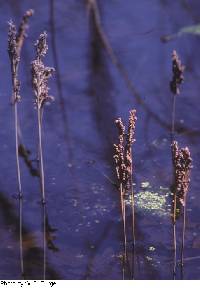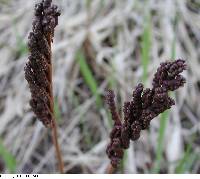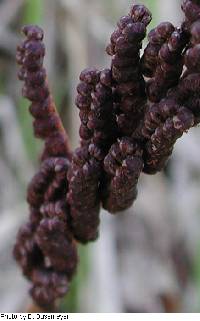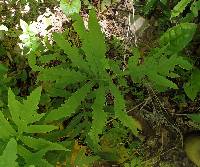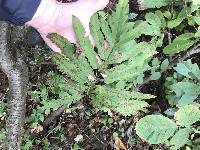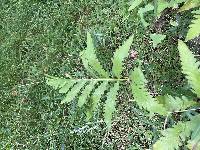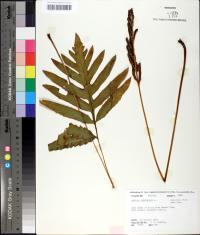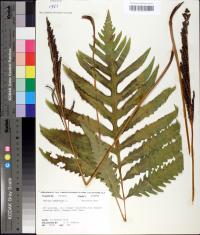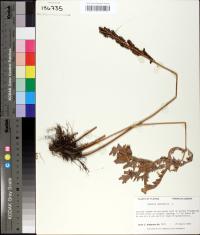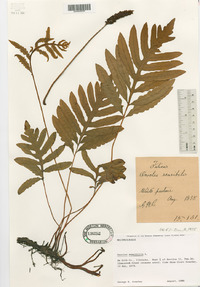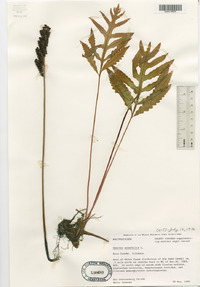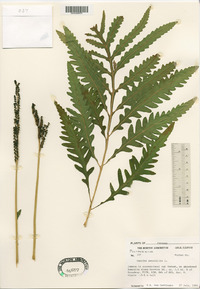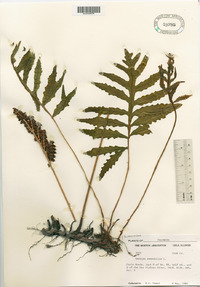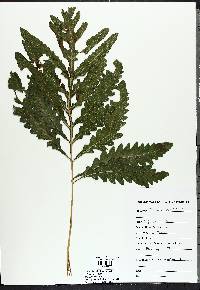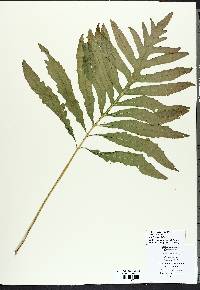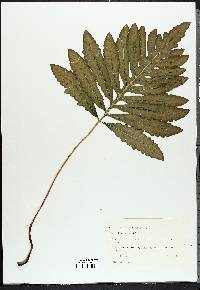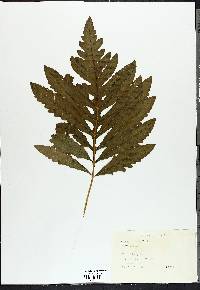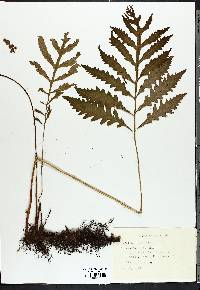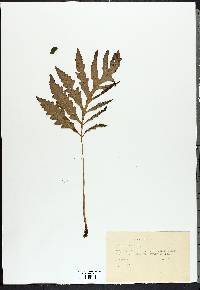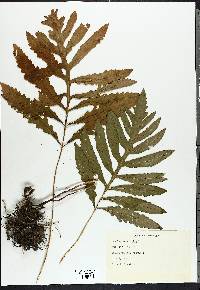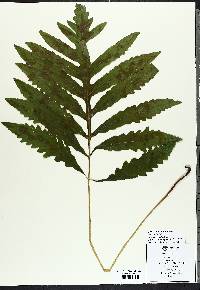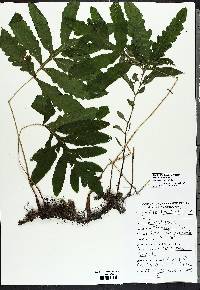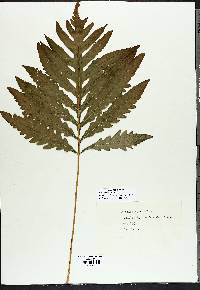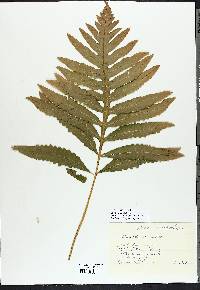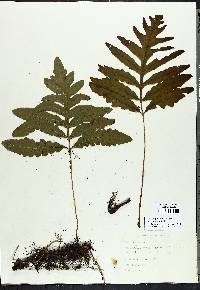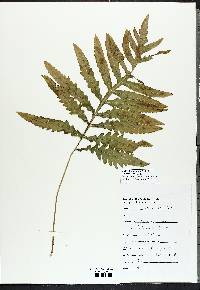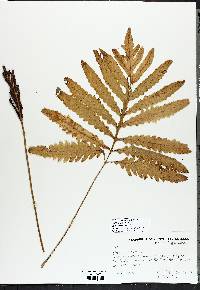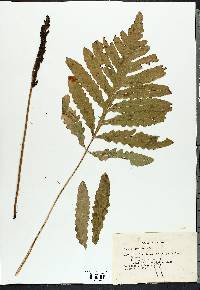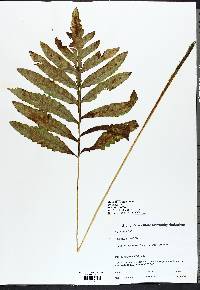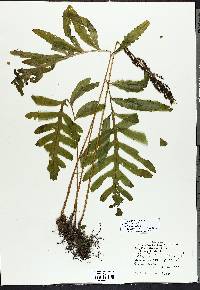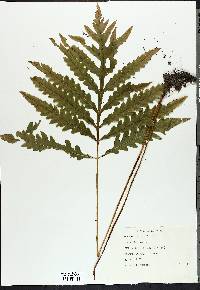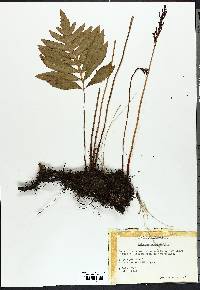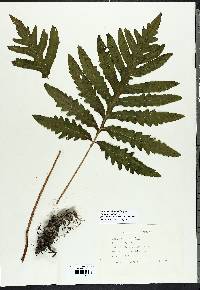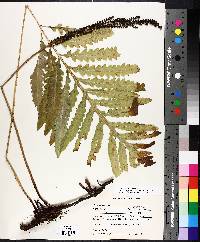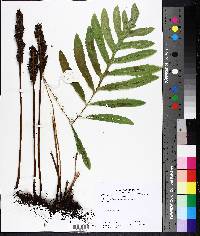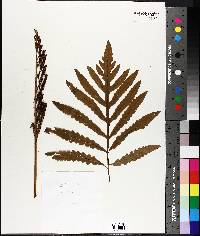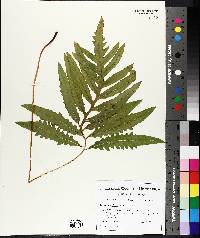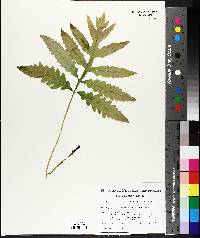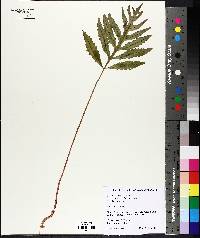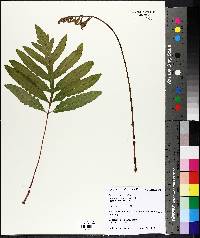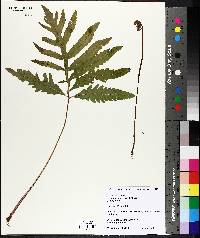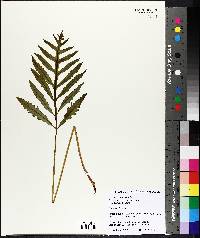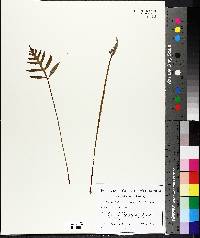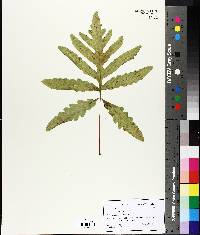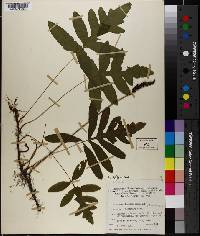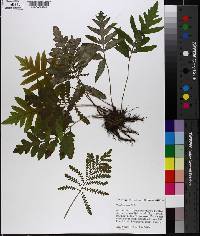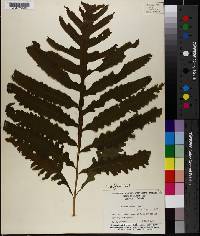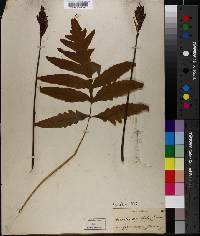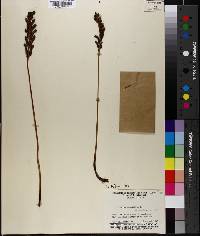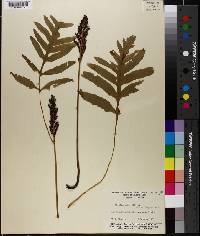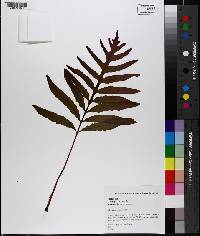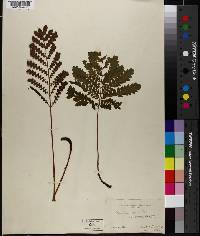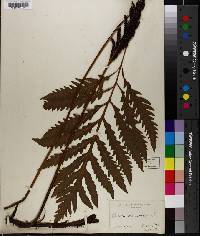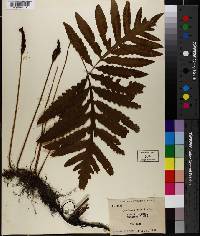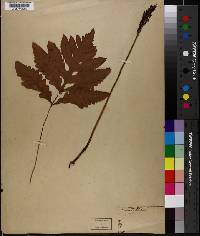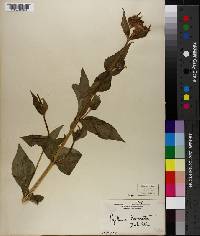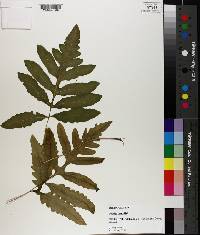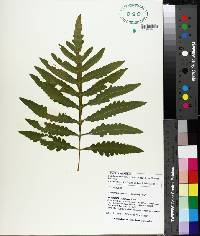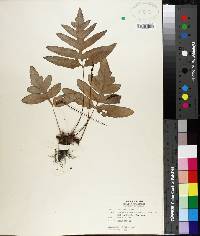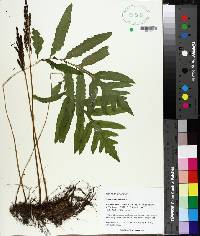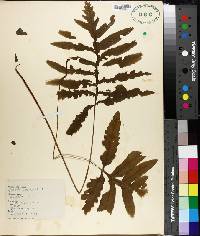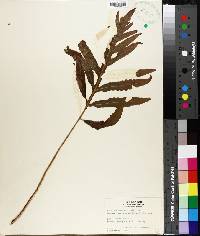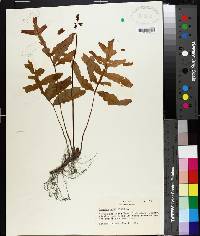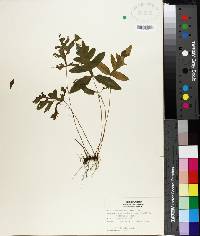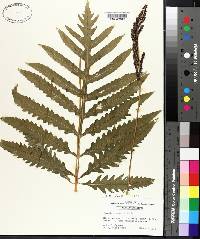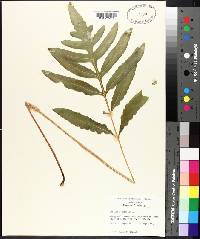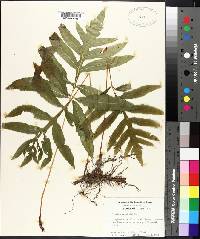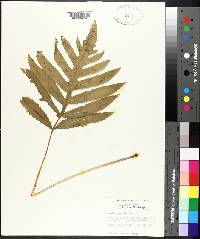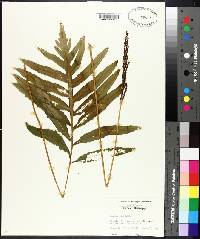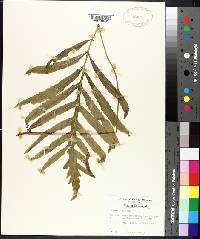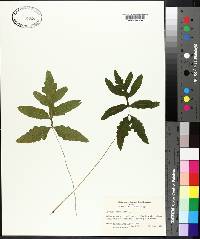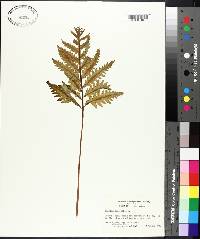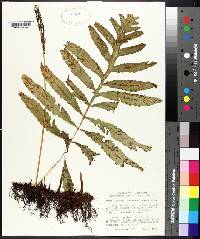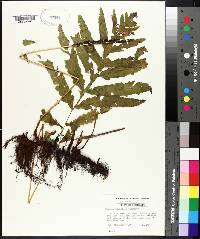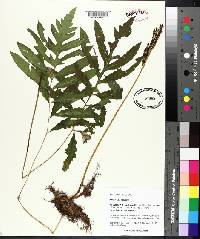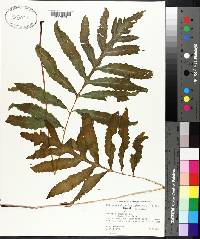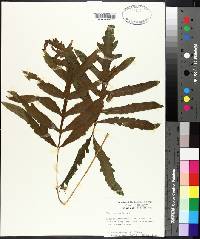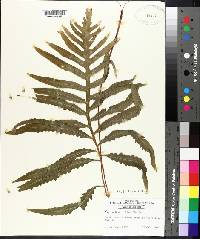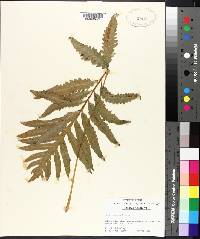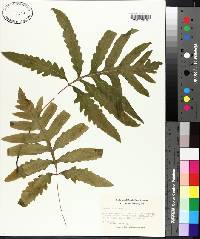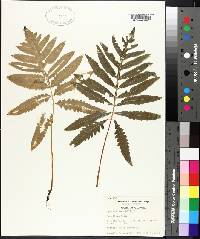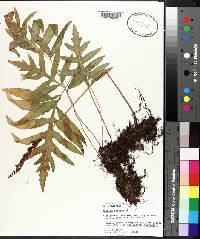Onoclea sensibilis
|
|
|
|
Family: Onocleaceae
Sensitive Fern
[Onoclea sensibilis f. obtusilobata (Schkuhr) Gilbert, moreOnoclea sensibilis f. ventroperaferens Neidorf] |
Leaves irregularly spaced along stem. Sterile leaves yellow-green, deltate, coarsely divided, 13--34 × 15--30 cm. Petiole of sterile leaf black, 22--58 cm, flattened at base; rachis winged, becoming broader toward apex. Pinnae 5--11 per side, lanceolate; proximal pinnae 9--18 cm, margins entire, sinuate, or laciniate. Sporophyll leaves green, becoming black at maturity, oblong, 7--17 × 1--4 cm. Petiole 19--40 cm, base sparsely scaly. Pinnae linear, 5--11 per side, 2.5--5 cm; ultimate segments revolute to form beadlike structures, 2--4 mm diam. Sori borne on free veins, enclosed by ultimate segments. 2 n = 74. Sporophylls produced May--October. Open swamps, thickets, marshes, or low woods, in sunny or shaded locations, often forming thick stands; 0--1500 m; St. Pierre and Miquelon; Man., N.B., Nfld., N.S., Ont., P.E.I., Que.; Ala., Ark., Colo., Conn., Del., Fla., Ga., Ill., Ind., Iowa, Kans., Ky., La., Maine, Md., Mass., Mich., Minn., Miss., Mo., Nebr., N.H., N.J., N.Y., N.C., N.Dak., Ohio, Okla., Pa., R.I., S.C., S.Dak., Tenn., Tex., Vt., Va., W.Va., Wis., Wyo.; e Asia. Onoclea sensibilis occurs in eastern North America, principally east of the Great Plains. Leaf forms with pinnae intermediate between those of sporophylls and sterile leaves, or with pinnae fertile only on one side of the blade, can occur on plants that also bear normal leaf forms. These do not merit taxonomic recognition (J. M. Beitel et al. 1981). Onoclea sensibilis resembles Woodwardia areolata (Linnaeus) T. Moore, with which it often grows. Onoclea has entire pinna margins and nearly opposite basal pinnae whereas Woodwardia areolata has serrate pinna margins and alternate pinnae. As in Matteuccia struthiopteris (Linnaeus) Todaro, sporophylls of Onoclea sensibilis persist through the winter and release the green spores in spring before the sterile leaves expand (R. W. Hill and W. H. Wagner Jr. 1974; L. G. Labouriau 1958; R. M. Lloyd and E. J. Klekowski Jr. 1970). Onoclea sensibilis is occasionally cultivated; it has a tendency to spread rapidly and become weedy. The name 'sensitive fern' refers to the susceptibility of the leaves to even a light frost.
Perennial fern 35 cm - 1 m tall Leaves: several, irregularly spaced, long-stalked, pinnately compound with narrow, fairly linear divisions (pinnae). Two kinds of leaves are produced: sterile leaves, which die back in winter (often browning at the lightest frost); and fertile leaves, which are produced in late summer and fall, and persist over winter, often up to two or three years. Rhizome: long-creeping, branching, black, stout, and sparsely scaly. Leaf stalks: irregularly spaced along rhizome, black, long (22 - 58 cm long on sterile leaves, 19 - 40 cm long on fertile leaves) with scales near the flattened, blackish, swollen bases. The swollen bases of the leaf stalks persist over winter and store starch grains, these structures are called trophopods. Spores: 64 per sac, greenish, all of one kind, single-sectioned (monolete), oblong or kidney-shaped, with a few folds and many minute projections. The spores give rise to the gametophyte (the sexual phase of the plant), which is small, green, heart-shaped, hairless or often with glands or hairs, and sits above the ground. Sterile leaves: yellow-green, herbaceous or papery, 13 - 34 cm long, 15 - 30 cm wide, widely triangular in outline, but pinnately divided into narrow segments with main "midrib" (rachis) widely winged (toward tip may only be pinnately lobed). On both surfaces of the leaf, the central main veins (rachis on main leaf, costae on the segments) are covered with linear to lance-shaped scales and / or multicellular hairs. Fertile leaves: green but turning black, hard, thick, 7 - 17 cm long, 1- 4 cm wide, oblong in outline, but pinnately divided twice. The five to eleven pairs of first divisions (pinnae) are alternate, 2.5 - 5 cm long, and linear in outline, but divided again into strongly inward-rolled secondary segments (pinnules), which form 2 - 4 mm diameter bead-like structures along the pinnae "midrib" (costae). Similar species: Onoclea sensibilis can resemble sterile plants of Woodwardia areolata, but that species does not have swollen leaf stalk bases, the pinnae are alternate and finely toothed, and the elongate sori are deeply sunken into the expanded pinnae tissue. The remnant fertile leaves of O. sensibilis may be confused with small fertile leaves of Osmunda cinnamomea, but the sporangia of that species are not arranged in clusters (sori) under the inward-rolled pinnae, but are rather exposed all along the surface of the fertile pinnae. Similarly, the fertile leaves of Matteuccia struthiopteris var. pensylvanica might be confused, but its fertile leaves are only divided once (once pinnate) and the sori are in rows covered by the inrolled pinnae edges. Habitat and ecology: Common, in a wide array of habitats including marshes, calcareous fens, boggy woodlands, moist areas of mesic woods, and muddy borders of shaded ponds. Occurence in the Chicago region: native Notes: This is the only species in the genus Onoclea (monotypic). This genus, like Matteuccia, is known to store starch grains in the persistent leaf stalk bases (trophopods). This character has been used by some to place the two genera into a separate family, the Onocleaceae. The common name of this plant, sensitive fern, refers to the extreme sensitivity to cold of the sterile leaves, which turn brown at first frost. Author: The Field Museum Sterile lvs to 1 m, the blade 18-40 נ15-35 cm, with a broadly winged rachis except near the base, the segments 8-12 pairs, opposite, 1.5-5 cm wide, with scattered white hairs on the midrib and veins beneath, glabrous above; fertile lvs smaller, the blade to 17 cm, the globular pinnules 3-4 mm wide; 2n=74. Swamps, open woods, and meadows in neutral to slightly acid soil; Nf. and Lab. to Fla., w. to Minn., Ark., Tex., and irregularly to Colo.; e. Asia. Gleason, Henry A. & Cronquist, Arthur J. 1991. Manual of vascular plants of northeastern United States and adjacent Canada. lxxv + 910 pp. ©The New York Botanical Garden. All rights reserved. Used by permission. From Flora of Indiana (1940) by Charles C. Deam Frequent throughout the state in low places in woodland, about lakes, and along roadsides. Forma obtusilobata (Schkuhr) Gilbert is a form with fronds intermediate between the normal fertile and normal sterile phases, bipinnate or nearly so, the pinnules flat and nearly free-veined, rarely partly fertile. This form has been found in Porter County by R. M. Tryon, Jr., who says it is not infrequent in meadows that have been mowed in the early part of the year. There is a specimen from Porter County in the herbarium of the University of Notre Dame. A form with the frond fertile, or somewhat so, on one side and sterile on the other is forma hemiphyllodes (Kiss & Kimmerle) Weatherby (Amer. Fern Jour. 26: 16. 1936). This form was found on the right of way of the Chicago, South Shore, and South Bend Railroad near Tremont, Porter County. The right of way was mowed earlier in the year. …… Indiana Coefficient of Conservatism: C = 4 Wetland Indicator Status: FACW |
|
|
|

